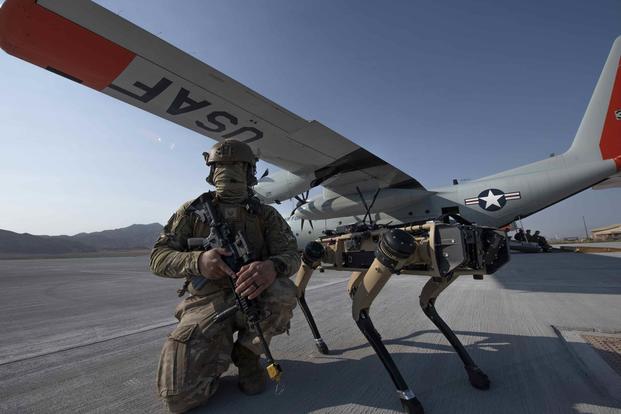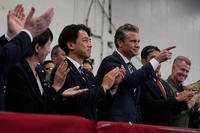After flying for more than a day miles above Earth, a large military drone charts and executes its own landing on a remote island in the Pacific. From takeoff to return, it has completed its entire mission without an active input or command from a human operator on station back in the states. But even this future scenario, featuring an unmanned system with advanced autonomy, is not entirely without human interaction.
Somewhere, a person is watching that drone and others like it, ready to intervene in case of system breakdown or an unpredicted crisis.
The vision to expand the Air Force's operational reach through advanced autonomous systems and artificial intelligence is inching closer to reality -- and the impact of that vision will affect not only drone operations but many other fields as well. Self-directed machines are candidates for any of the mundane or risky tasks that make up much of an airman's workload, whether in engineering, security, maintenance or a spectrum of other careers. What the Air Force must determine as that future approaches is how this new operational reality will affect the roles and responsibilities of human airmen and the structure of their work.
Read Next: Army Beats 2020 End Strength Goal Despite Major Recruiting Roadblocks
"I think in some areas, we're on the brink [of major advances in AI and automation]," Brig. Gen. David Harris, the director of the Air Force Warfighting Integration Capability office, known as AFWIC, said in an interview this week. The service's think tank-like organization stood up in 2018 to analyze where it could use innovative solutions to close gaps or enhance mission sets.
"The remotely piloted aircraft [enterprise] ... those things can come to fruition much faster than other aspects of automation, depending on the amount of time and funding the Air Force puts these efforts," he said.
In today's operations, RPA pilots and sensor operators sit on station for hours monitoring their drone's movements, from the start of its mission to its accomplishment or the system's recovery.
The proposed drone of the future "can get into the field in combat, land wherever it needs to, it has maps memorized about different runways and where it can taxi ... those are things that we can see coming in the very short term," Harris said.

It's not just drones: Automation and AI will give a boost to intelligence analysts who gather complex or data-heavy information; medical or administrative professionals who use scores of files or records; maintainer airmen virtually simulating how to fix an aircraft part before doing the real job; and even stealth fighter pilots, who will someday fly side by side with backup wingman drones.
Many, if not most, jobs will change with new training models to incorporate emerging technologies. But despite the predicted technological revolution, officials say there's no plan -- at least right now -- to cut out entire career fields threatened with obsolescence by machines, according to officials who recently spoke with Military.com.
"There's an old saying that if you want to use robotics and automation in three different areas, when it is dull, dirty or dangerous," said Bob Work, the Pentagon's former Deputy Secretary of Defense under the Obama administration.
Work, speaking in his personal capacity to Military.com, was instrumental in promoting human-machine collaboration within the Pentagon's "Third Offset" strategy, the Defense Department's quest to develop technologies for the U.S. to exploit against adversaries like Russia and China.
"Over time, without question, as autonomy gets better, and as we develop concepts of operations with different types of autonomous applications, the expectation is, you may be able to replace humans in jobs that they have today," Work said. "That doesn't mean that you would get rid of the humans; you would most probably divert the human to a different task, which was more suited to having human oversight."
The Air Force could invent a new Air Force Specialty Code, or job category, solely concentrated on emerging technologies or Science, Technology, Engineering and Math (STEM) programming, he said.
"You're still going to need technicians to be able to program, code and get after that line of method as well," added Harris.
Machines are less likely to take over entire jobs held by humans, and more likely to take on specific tasks and functions, said Capt. Mike Kanaan, director of operations for AI Accelerator, the Air Force's joint venture program with Massachusetts Institute of Technology. And that, he added, will allow humans to specialize and excel.
"It's going to free up humans to be more human," Kanaan said. "Our lives, our jobs are far too often computer tasks -- not jobs."
"If we take away the minutiae of airman's lives, in every single job, we will outwit, out innovate and outmatch -- there is no question about that," said Kanaan, also the author of "T-Minus AI: Humanity's Countdown to Artificial Intelligence and the New Pursuit of Global Power. "We're going to do more with people ... and be more thoughtful about what we do."
'Nowhere Close' to Replacing Humans
Pentagon officials have long said that if troop operations are augmented by some kind of smart-thinking machine, a person would remain on standby -- a human "on the decision loop, versus in the decision loop."
That's because leaders don't believe in ceding complete trust to the technology, said a retired Air Force general familiar with AI and algorithmic warfare who spoke to Military.com on background to discuss the subject matter freely.
"We're nowhere close to replacing people wholesale in areas like intel analysis," the retired general said. While automation will find its way into the field, he said, the technology that enables a machine to evaluate crucial intelligence "isn't advanced enough yet."
"[Even if we] assume it's getting closer and closer to that point, you still need people to do a lot more that they weren't getting [to] period, because they didn't have the ability to go process the volumes of information that were coming in. The realist in me says, 'Yes, some people will be replaced,' but they'll be moved to an equally important task that they couldn't get to before. In terms of sort of these big ... wartime functions, I think you're going to see a lot more focus on just human-machine teaming," which in the long run may actually require more people, he said.
Arbitrarily cutting people in favor of machines has consequences, especially if the technology hasn't been proven -- something the Air Force wants to be especially careful of in this case, having nearly been burned before.
In 2018, there was an internal dispute among leaders on a plan to cut 5,000 intelligence personnel within the top echelons of the ISR field by 2028. Senior leaders wanted to include a reduction mandate in the service's "Next Generation Intelligence, Surveillance, and Reconnaissance Dominance Flight Plan," the retired general said. The study is the service's blueprint to incorporate more autonomy and data from multiple sensors across platforms stationed around the globe.
Yet the deputy chief for ISR at the time compromised "to say, 'replace-slash-repurpose,'" said the general, who was involved with the discussions.
"To put that in [with a corresponding end] date while the technology is so fragile and brittle today was hard to project," the general said.

A similar conversation may take place regarding Air Force refueling boom operators.
Last month, Dr. Will Roper, assistant secretary of the Air Force for acquisition, technology and logistics, revealed that the Air Force has begun drawing up plans for its next refueling tanker to have autonomous or semi-autonomous capabilities, thanks in part to efforts to fix the KC-46 Pegasus. Roper said that the required redesign of the KC 46's Remote Vision System (RVS), now known as RVS 2.0, which permits the in-flight operator to view the refueling system below the aircraft, is bringing the tanker to the brink of autonomous refueling.
A piece of that has already been demonstrated, said a former Air Force tanker pilot who now works within the defense industry. The pilot was asked not to be identified because they are not authorized to speak on the topic publicly.
In April, Airbus achieved the first fully automatic air-to-air refuelling using an aircraft mapping scheme, which assesses the type of aircraft coming in to receive the fuel and relays the information to the tanker. The system on board is able to understand generally where the aircraft's receptacle is based on the make of the aircraft, and can immediately hook on and begin fueling.
But the pilot said the Air Force should remain leery of getting rid of human operators yet, for these reasons: "There's motion involved, and there are variables [such as] bumps you experience in flight that you didn't see coming," the pilot said.
"So having a human in there to ... anticipate that something could happen, and then when it does, you can fly the boom out of the way," the pilot continued. "That's really difficult to replicate through autonomy."
"An automated system has to have those safeguards in it, and you can do it, it's just going to have to be proven through tests and [hundreds of] probability runs," the pilot said.
Making the Leap
AI and automation aren't new concepts. The Pentagon has used a handful of automated systems -- including missile detection and tracking and computerized functions in its fighter jets -- for decades.
But the two technologies aren’t equivalent, and can’t be used for everything, Kanaan said. And if airmen are to employ automation or AI successfully, massive amounts of data has to be streamlined first.
"That's why there are efforts in digitization, because only then can you make smart choices about where automation should be number one, and only then can AI illuminate any meaningful insights," he said.

But it's time for the services to use these evolutions in technology -- big data, AI -- in smarter ways, and fast, according to a former Air Force official who now works in the tech industry. That means the service is racing the clock to determine how intelligence and increasingly capable machines will affect the role of humans in the ranks.
"The military has not invested in evolving its architectures, its data centers -- like getting out of physical data centers," the tech expert said, referencing the transition to cloud computing. The tech industry expert asked not to be identified.
After years of devoting attention to counterinsurgency conflicts, "the people making policies are viewing trades and specialties in a very traditional way," the expert said. "They're not really fully understanding the fundamental sea change that's taking place with regards to the digital age. That's a big problem.
"Unless those conditions change, we're going to be behind very, very quickly -- arguably, we're already falling behind," the expert said.
There have been cumulative gains. The Air Force, for one, is moving full speed ahead with a strategy to link weapons and capabilities for more centralized oversight and control. Known as the Advanced Battle Management System, the state-of-the-art program focuses on fusing ISR sensor data from a variety of weapons and spacecraft anywhere in or around the world.
The endeavor requires hundreds of people, from the unit level to the combatant command levels. The Air Force's largest ABMS test to date, held last month, involved U.S. Northern Command and U.S. Space Command, and included "70 industry teams, 65 government teams from every service including the Coast Guard, 35 military platforms, 30 geographic locations and four national test ranges," the service said in a release.
The experiments thus far have shown that the service continues to develop applicable tech that works in tandem with the warfighter -- rather than pushing the human out.
ABMS will eventually affect robotic warfare too. As part of the recent ABMS test, the Air Force sent out "robot dogs" at Nellis Air Force Base, Nevada, to survey the terrain and give Security Forces airmen additional situational awareness when opening an airfield.
Another leap-ahead initiative is the Air Force's Skyborg program, which will develop AI-enabled drones that can someday go out ahead of fighter jets and respond to incoming threats in an effort to safeguard their human pilot wingman. Those drones will be gathering data and relaying it back to the pilot -- and into a wide-ranging network -- instantaneously. Officials intend for Skyborg to be operational by 2023 at the earliest.
Work, now a chairman of the National Security Commission on Artificial Intelligence, said the services are demonstrably further in their tech evolution -- with ABMS and Skyborg trials -- than the days of the Third Offset strategy. "But in my view, we're still moving too slow," he said.
"The Chinese and the Russians are both trying to surpass the United States, in terms of military power [with automation and] AI-enabled applications," he said. "So I'm never satisfied, we're moving fast enough. We have to take this seriously."
"There's an old adage [about] politicians who are running for office, and they always say, 'Regardless what the polls say, run like you're losing,'" Work added. "We have to pursue these technologies aggressively. We have to run like we're losing."
-- Oriana Pawlyk can be reached at oriana.pawlyk@military.com. Follow her on Twitter at @oriana0214.
Related: The Days of Secret Military Operations May Soon Be Over. Does That Matter?














